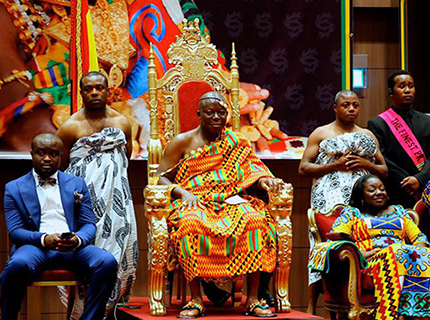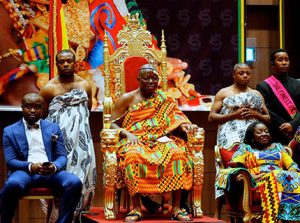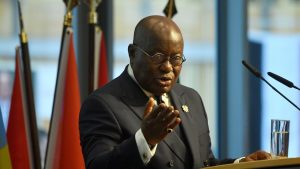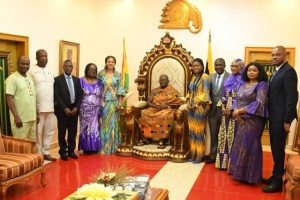Today, January 25, 2024, the Manhyia Palace Museum with the Victoria & Albert Museum in London, and the British Museum announced details of an important cultural collaboration.
Items of gold and silver regalia associated with the Asante royal court will be displayed at the Palace Museum in Kumasi later this year as part of a long-term loan commitment by the V&A and the British Museum.
Many of these items will be seen in Ghana for the first time in 150 years.
The partnership follows an official visit to London by the Asantehene (King of Asante) Otumfuo Osei Tutu II in May last year at which he met with the leadership of these partner organisations. His two technical advisors- the Ghanaian historian Ivor Agyeman-Duah and the British professor of African and Asante history, Malcolm McLeod, instrumental in setting-up the Manhyia Museum in 1995, led the discussions and negotiations with the partner leadership in the last nine months.
The objects will be loaned, under separate agreements, to the Manhiya Palace Museum, which is located within the palace complex of the Asantehene in Kumasi. The collections will form part of an exhibition planned to celebrate the 2024 Silver Jubilee of His Royal Majesty, the Asantehene, Osei Tutu II, as well as commemorating the 150th anniversary of the 1873-4 Anglo-Asante war and the 100th anniversary of the return of the Asantehene Prempeh I from exile in the Seychelles.
These objects are of cultural, historical and spiritual significance to the Asante people. They are also indelibly linked to British colonial history in West Africa, with many of them looted from Kumasi during the Anglo-Asante wars of the 19th century. Some of these formed part of a British indemnity payment forcibly extracted from the Asantehene at the time, while many others were sold at auction and later dispersed among museums and private collectors worldwide, including the British Museum and the V&A.
The V&A is lending seventeen items in total. This collection includes all 13 pieces of Asante Royal regalia acquired by the Museum at an auction in April 1874 of gold looted by the British army during the raid on and destruction of the royal palace on 4th-6th February: 1 gold peace pipe, 3 cast gold soul-washers’ badges, 7 sections of sheet-gold ornament, 1 silver straining spoon, 1 pair of silver anklets. Also travelling to Kumasi are two further items of gold regalia bought by the V&A within a decade of the raid: 1 section of sheet-gold ornament purchased in 1874 from a military family and 1 cast gold soul-washer’s badge purchased in 1883 with no record of the previous owner. Two further items include 1 gold ring given to us by a collector in 1921 and 1 gold ornament in the form of an eagle given by a military family in 1936.
The fifteen objects selected by the Manhyia Palace Museum from the British Museum include a small gold ornament in the form of a lute-harp (sankuo). This ornament was one of the cast gold objects presented in 1817 to British diplomat Thomas Bowdich during his trip to Kumasi to negotiate a trade treaty with the Asantehene Osei Bonsu. According to Bowdich, they were intended by the Asantehene as gifts for the British Museum and served as a means of representing the wealth and status of the Asante nation. The inclusion of the sankuo highlights the long-term connections between the British Museum and the Asantehenes, now nearly 200 years old.
Other objects selected from the Museum include items of regalia associated with two of the 19th century Anglo-Asante wars (1873-4 and 1895-6), much of which was looted directly from the palace(s) in Kumasi and most of which formed part of the regalia of respective Asantehenes, Kofi Karikari (c.1837-1884) and Prempeh I (1870-1931).
Since the foundation of the Asante empire during the late 17th century, gold has been central to Asante identity, spirituality and economic stability. Asante kings grew powerful on local gold deposits and the palace in Kumasi became the focal point for a lucrative international gold trade.
Gold regalia is the ultimate symbol of Asante royal government: it decorates the royal throne, is worn by high-ranking court officials and above all, decorates the Asantehene who is richly adorned with gold ornaments at royal ceremonies.
These ornaments carry meaning beyond their material value. They are invested with the spirits of former Asante kings and their decoration can be read by those familiar with the visual lexicon.
Of the hundreds of items of gold regalia looted from the Palace in 1874, the V&A (then the South Kensington Museum) selected pieces that were exemplars of the brilliant goldsmithing techniques practiced for centuries by the Asante royal goldsmiths and displayed them as a sourcebook for British artists and designers seeking inspiration for new work.
Director of the V&A, Dr. Tristram Hunt said: ‘150 years after the attack on Kumasi and looting of court regalia, the V&A is proud to be partnering with the Manhiya Palace Museum to display this important collection of Asante gold work. As part of our commitment to sharing collections with a colonial past, we are excited to see these items on public show, in Ghana, as part of Asantehene Otumfuo Osei Tutu II’s Silver Jubilee celebrations. We thank the Asantehene for his leadership, and look forward to further collaboration.’
Keeper of Africa, Oceania and the Americas British Museum, Lissant Bolton said:
‘We are privileged to have built a long-standing cultural partnership with the Manhyia Palace Museum, working together over the past five decades. This relationship is of great importance to us. We are delighted to be lending these beautiful and significant cultural objects for display in Kumasi in this the Asantehene’s Silver Jubilee year and the 150th anniversary of the Anglo-Asante war, and to be doing so through a collaboration with Manhyia Palace Museum and the V&A.’
Notes
:17 items from the V&A collection are planned for loan to the Manhyia Palace Museum, on the basis of a long term (three-year) renewable agreement. More information on these objects can be found here
:15 items from the British Museum are planned for loan to the Manhyia Palace Museum, on the basis of a long term (three year) agreement.
More information on the British Museum’s African Galleries can be found here
The V&A
The V&A is a family of museums dedicated to the power of creativity— its power to entertain and move, to enrich our lives, open our minds and change the world. We celebrate and share that power through a programme of exhibitions, events, educational and digital experiences, a collection of 2.8 million objects, and through our support for new works and commitment to conservation, research and sustainable design. Together, our work tells a 5,000-year-old story of creativity, helping to advance cultural knowledge everywhere, and inspiring the makers, creators and innovators of today and tomorrow. We are always working to broaden our audiences so that everyone can be part of the V&A – because the V&A and the power of creativity belong to us all.
The British Museum
Founded in 1753, the British Museum was the first national public museum in the world. The Collection of around 8 million objects tells the stories of cultures across the world, from the dawn of human history, over two million years ago, to the present. Objects range from the earliest tools made by humans and remarkable finds from the ancient world to more recent acquisitions from Africa, Oceania and the Americas, the Middle East, Asia and Europe, as well as the national collections of prints and drawings, and coins and medals. In addition to work in London, the Museum takes part in an extensive programme of loans and tours, both across the UK and throughout the world. Research with international impact continues to underpin the British Museum’s exhibitions and wider work.







